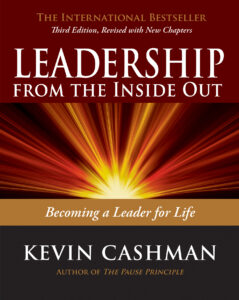Grow the Whole Person to Grow the Whole Leader
I first read Leadership From the Inside Out years ago. It is one of the books that helps build a foundation of knowledge for leaders. That’s why I was excited to see that it is now out in a new version with updated chapters, new case studies and stories, and even more practical exercises to help everyone achieve their leadership potential.
Author Kevin Cashman is the Global Leader of CEO & Executive Development at Korn Ferry. He has advised thousands of senior leaders across almost every industry.
We recently talked about his updated book and his leadership views.
You’re just out with a new version of Leadership From the Inside Out, a classic must-read in leadership circles. What prompted you to update it, and what’s new?
Well, thank you for endorsing it as a “must-read.” It has been humbling and fulfilling to witness the success of each edition. Twenty years ago, when the first edition came out, it was one of the first books to deeply connect personal growth to leadership effectiveness using timeless, enduring principles of human development. We had been seeing how this “grow the whole person to grow the whole leader” approach resonated in our practice with CEOs, CEO successors and executives, but at that time, there was little or no research on these principles—authenticity, self-awareness, courage, character, purpose—and their impact on results. We did the second edition in 2008 to share new stories and case studies, but also to share some of the mounting research from independent sources that was catching up with what we were seeing in the trenches. For this third edition, we felt compelled to share more abundant recent research, including a study that directly connects top leader self-awareness with organizational financial performance, a study on the results of purpose-driven leadership’s significant impact on financial growth, and more. The book is still framed in areas of mastery, but we’ve added Story Mastery and Coaching Mastery, both taking leaders to deeper levels of awareness to enhance their influence and multiply it. We updated stories and case studies and added and revised exercises and practices to sharpen relevance. This third edition is an even deeper, integrative growth experience.
Why Character is Central to Leadership
I’m a passionate believer in character, and your book was early to focus on this aspect of leadership. Would you comment on the centrality of character?
Leading in Character is foundational, or to use your word, “central” to Personal Mastery, which is the ongoing growth of authenticity, courage, and influence that has enduring value. It is at the heart of transformative impact and servant leadership. Both Character and Coping are present in most leadership situations. However, we need to ask ourselves, “Which one is my master, and which one is my servant?” When we are self-aware and make Character the master of our leadership and Coping the servant, we move toward better relationships with team members, customers, employees, all our stakeholders and the greater marketplace. And, we create more sustainable value. As leaders, it is essential to learn how to build our awareness of when we are being guided by Character and when we are being pushed by Coping. One CEO we worked with in our Chief Executive Institute told us that learning how to pause to make sure that values are on the table and that she and her team were leading with character has really stayed with her and been significant. She developed a systematic process of asking her team for their expert opinions, probing them to explain how they came to that opinion and whatever concerns they had. She explained that when a problem or a crisis comes along “stepping through it is grounding and everyone has the same fact base. It encourages synthesis and congruence with values.” That’s leading with Character and Authenticity.
Meditation and Leadership
Meditation and mindfulness have become major topics in business settings. What accounts for this trend?
You are so right. Twenty years ago, it was rare to include meditation or mindfulness in conversations about leadership and leadership development. We were maybe the first to do so with the first edition of Leadership from the Inside Out in the chapter on Being Mastery, where I talked about my personal experience with meditation and a long, silent retreat in which I learned to explore Being through meditation and non-doing. The trend or movement to incorporate meditation and mindfulness in our leadership is an acknowledgment that we need to discover more ways to resolve leadership challenges. While we are called to be more innovative and agile amid increasing volatility, uncertainty, complexity and ambiguity, we need to discover ways to be more within ourselves, to find more balance and be more grounded, to give ourselves space, like the space between the notes, to connect ideas and achieve clarity. We need to go to deeper levels within our selves—our being—to reflect and, although it sounds paradoxical, to experience more non-doing. Einstein said, “We cannot solve our problems with the same thinking we used when we created them.” Meditation and mindfulness help us develop and go to a different level.
Master Your Purpose
You start with personal mastery. Purpose mastery is early in the book. It “elevates leaders and teams to move from short-term success to long-term significance.” So often I see the next generation especially searching for purpose. What are some tips for leaders who want to up their mastery of purpose?
Great question. We’ve identified Eight Principles of Purpose Mastery in the book. Here’s the first five. These will help anyone who wants to “up their mastery of purpose.”
- Get in touch with what is important to you. Understand your values and what gives meaning to your life.
- Act “On-Purpose.” Clarify your purpose and turn it into a commitment.
- Find Team Core Purpose. While personal purpose is transformative, team purpose is powerful for the entire enterprise.
- Do Not Mistake the Path for the Goal: Be careful not to simply adopt other people’s views of your purpose. The essence of Purpose Mastery is the very personal process of discovering how your gifts can serve something bigger.
- Focus on Service
There’s also a write-up in the book of an excellent study called “People on a Mission,” which targets purpose-driven leadership and purpose-driven companies. We’ve extracted some key practices that fueled success that are valuable for embedding purpose into the policies, structures and practices in a company.
Resilience Mastery
Another “mastery” that struck me was resilience mastery. You referenced a quote by E.B. White that you revised in a witty way to more accurately express the dilemma many leaders face. I loved that perspective. Would you comment on resilience?
 Resilience is overwhelmingly the mastery area that CEOs tell us is the most challenging for them, and I have to agree. Resilience Mastery is about moving from time management to energy leadership. We each need to find a formula that incorporates a healthy mix of what gives us energy. Most CEOs I advise have some type of energy-building, fitness and life-support routine. These range from daily swims, Pilates, yoga, and triathlon or marathon training to meditation, massage, reading, time with loved ones, and sleep. I have tweaked the E.B. White quote from the children’s book Charlotte’s Web as a way to offer a witty but insightful perspective: “I arise in the morning torn between a desire to save the world and a desire to savor the world. This makes it hard to plan the day.” How often do you feel the tension between your desire to serve and your need to savor? It’s not always easy because both are so important. Resilience Mastery is not a static, rigid process; it is a type of centered fluidity that lets us go in any direction with ease and agility. Being resilient means we can recover our balance even in the midst of action. Separating our career, personal, family, emotional and spiritual lives into disparate pieces and then trying to balance the parts on a scale is impossible. Managing the entire dynamic is key. We need to identify the dynamics that run through all the pieces and then influence our resilience at that level. Mastery of Resilience is about practicing inner and outer behaviors that keep us grounded and centered so we can deal with all the dynamics outside.
Resilience is overwhelmingly the mastery area that CEOs tell us is the most challenging for them, and I have to agree. Resilience Mastery is about moving from time management to energy leadership. We each need to find a formula that incorporates a healthy mix of what gives us energy. Most CEOs I advise have some type of energy-building, fitness and life-support routine. These range from daily swims, Pilates, yoga, and triathlon or marathon training to meditation, massage, reading, time with loved ones, and sleep. I have tweaked the E.B. White quote from the children’s book Charlotte’s Web as a way to offer a witty but insightful perspective: “I arise in the morning torn between a desire to save the world and a desire to savor the world. This makes it hard to plan the day.” How often do you feel the tension between your desire to serve and your need to savor? It’s not always easy because both are so important. Resilience Mastery is not a static, rigid process; it is a type of centered fluidity that lets us go in any direction with ease and agility. Being resilient means we can recover our balance even in the midst of action. Separating our career, personal, family, emotional and spiritual lives into disparate pieces and then trying to balance the parts on a scale is impossible. Managing the entire dynamic is key. We need to identify the dynamics that run through all the pieces and then influence our resilience at that level. Mastery of Resilience is about practicing inner and outer behaviors that keep us grounded and centered so we can deal with all the dynamics outside.
The best model for resilience exists in nature. All resilience in nature comes about through alternate cycles of rest and activity. The cycles of day and night and the seasonal cycles constantly balance a rest phase with an active phase. Nature expresses its vitality in the active phase and reconnects with its vitality in the rest phase. Each phase interacts in just the right combination to achieve dynamic balance. Our lives are similar with one major difference: We get to choose the quantity and quality of actives and rest. When we choose inappropriately, our life is out of whack. When we choose well, we experience vitality.
Stepping back from your writing, you are also Global Leader of CEO & Executive Development at Korn Ferry, and you have the opportunity to see many leaders in action. What leadership qualities are more in demand today than they were a few decades ago?
I would have to say that most leaders would agree that Personal Mastery and Interpersonal Mastery are most relevant. But Purpose Mastery is being recognized more and more as a driving force, keeping us connected to those three important questions: Who am I? Where am I going? Why am I going there? Leaders are asking these three questions of themselves and of their organizations. Purpose Mastery is a bridge that connects Personal Mastery to Interpersonal Mastery. The results are significant and inspiring. Resilience Mastery, although it is so challenging, is certainly more in demand for leaders. The new normal of global travel, 24/7 digital connections and being tethered to a global clock compel us to make choices that serve us in all aspects of our leadership and our lives.
For more information, see Leadership From the Inside Out.

